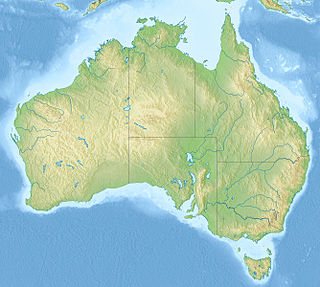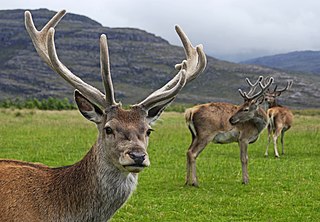
Conservation in Australia is an issue of state and federal policy. Australia is one of the most biologically diverse countries in the world, with a large portion of species endemic to Australia. Preserving this wealth of biodiversity is important for future generations. 25% of Australia is managed for conservation.

The Department of Foreign Affairs and Trade (DFAT) is the department of the Australian federal government responsible for foreign policy and relations, international aid, consular services and trade and investment. Australia's total official development assistance (ODA) decreased in 2022 due to differences in Australia's financial year reporting and the timing of its COVID-19-related expenditure, representing 0.19% of gross national income (GNI).

The New South Wales Office of Environment and Heritage (OEH), a former division of the Government of New South Wales between April 2011 and July 2019, was responsible for the care and protection of the environment and heritage, which includes the natural environment, Aboriginal country, culture and heritage, and built heritage in New South Wales, Australia. The OEH supported the community, business and government in protecting, strengthening and making the most of a healthy environment and economy within the state. The OEH was part of the Department of Planning and Environment cluster and managed national parks and reserves.
The Department of Industry, Innovation, Climate Change, Science, Research and Tertiary Education was a department of the Australian Government charged with further developing growth in Australian industries and advancements in science and research.

The Department of the Prime Minister and Cabinet (PM&C) is a department of the Australian Government with broad-ranging responsibilities; notably, intergovernmental and whole of government policy coordination and assisting the prime minister of Australia in managing the Federal Cabinet. The PM&C was established in 1971 and traces its origins back to the Prime Minister's Department established in 1911.

The Environment Protection and Biodiversity Conservation Act 1999(Cth) is an Act of the Parliament of Australia that provides a framework for protection of the Australian environment, including its biodiversity and its natural and culturally significant places. Enacted on 17 July 2000, it established a range of processes to help protect and promote the recovery of threatened species and ecological communities, and preserve significant places from decline. The Act is as of September 2024 administered by the Department of Climate Change, Energy, the Environment and Water. Lists of threatened species are drawn up under the Act, and these lists, the primary reference to threatened species in Australia, are available online through the Species Profile and Threats Database (SPRAT).

The Australian environment ranges from virtually pristine Antarctic territory and rainforests to degraded industrial areas of major cities. Forty distinct ecoregions have been identified across the Australian mainland and islands. Central Australia has a very dry climate. The interior has a number of deserts while most of the coastal areas are populated. Northern Australia experiences tropical cyclones while much of the country is prone to periodic drought. This dry and warm environment and exposure to cyclones, makes Australia particularly vulnerable to climate change -- with some areas already experiencing increases in wildfires and fragile ecosystems.

The Australian Minister for the Environment and Water is a position which is currently held by Tanya Plibersek in the Albanese ministry since 1 June 2022, following the Australian federal election in 2022.

Climate change has been a critical issue in Australia since the beginning of the 21st century. Australia is becoming hotter and more prone to extreme heat, bushfires, droughts, floods, and longer fire seasons because of climate change. Climate issues include wildfires, heatwaves, cyclones, rising sea levels, and erosion.

The Minister for Resources is an Australian Government cabinet position which is currently held by Madeleine King following the swearing in of the full Albanese ministry on 1 June 2022.

The Minister for Climate Change and Energy is a portfolio in the Government of Australia. The current Minister is Chris Bowen. The minister administers his or her portfolios through the Department of Climate Change, Energy, the Environment and Water.

An Indigenous Protected Area (IPA) is a class of protected area used in Australia; each is formed by voluntary agreement with Indigenous Australians, and declared by Aboriginal Australians and Torres Strait Islander representative organisations. Each is formally recognised by the Australian Government as being part of its National Reserve System. The areas may comprise land and sea, and are managed by Indigenous groups for the conservation of biodiversity. Managing IPAs also helps to protect the cultural values of their country for future generations, and has benefits for Indigenous health, education, economic and social cohesion.

Greenhouse gas emissions by Australia totalled 533 million tonnes CO2-equivalent based on greenhouse gas national inventory report data for 2019; representing per capita CO2e emissions of 21 tons, three times the global average. Coal was responsible for 30% of emissions. The national Greenhouse Gas Inventory estimates for the year to March 2021 were 494.2 million tonnes, which is 27.8 million tonnes, or 5.3%, lower than the previous year. It is 20.8% lower than in 2005. According to the government, the result reflects the decrease in transport emissions due to COVID-19 pandemic restrictions, reduced fugitive emissions, and reductions in emissions from electricity; however, there were increased greenhouse gas emissions from the land and agriculture sectors.
The Department of Regional Australia, Local Government, Arts and Sport was an Australian government department. It was formed in December 2011, absorbing the former Department of Regional Australia, Regional Development and Local Government along with Arts and Sport functions from the Department of the Prime Minister and Cabinet. The department was abolished in September 2013 with its functions moved to other Australian Government departments.
Blair Robert Comley is an economist. He is a former Secretary of the New South Wales Government Department of Premier and Cabinet, replaced by a new Secretary upon the election of the then Premier of NSW, The Hon Gladys Berejiklian.
Finn Axel Pratt is a retired senior Australian public servant. He was most recently Secretary of the Department of the Environment and Energy.
The Department of the Environment and Energy (DEE) was an Australian government department in existence between 2016 and 2020.

This article gives an overview of the structure of environmental and cultural conservation in Scotland, a constituent country of the United Kingdom.
The Australian Department of Agriculture, Water and the Environment (DAWE) was an Australian Government department which operated from 1 February 2020 until 30 June 2022. It represented Australia's national interests in agriculture, water and the environment.










